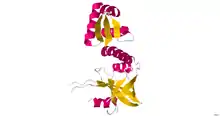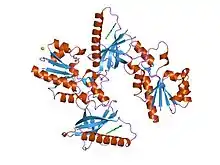核黄素激酶
但是,在古菌核黄素激酶(EC 2.7.1.161)中,常使用CTP而非ATP作为反应底物,催化如下反应:
- CTP + 核黄素 CDP + FMN [2]
| riboflavin kinase 核黄素激酶 | |||||||
|---|---|---|---|---|---|---|---|
 | |||||||
| Thermoplasma acidophilum中的核黄素激酶晶体结构[1] | |||||||
| |||||||
| 识别码 | |||||||
| EC编号 | 2.7.1.26 | ||||||
| CAS号 | 9032-82-0 | ||||||
| 数据库 | |||||||
| IntEnz | IntEnz浏览 | ||||||
| BRENDA | BRENDA入口 | ||||||
| ExPASy | NiceZyme浏览 | ||||||
| KEGG | KEGG入口 | ||||||
| MetaCyc | 代谢路径 | ||||||
| PRIAM | 概述 | ||||||
| PDB | RCSB PDB PDBj PDBe PDBsum | ||||||
| 基因本体 | AmiGO / EGO | ||||||
| |||||||
| Riboflavin kinase 核黄素激酶 | |||||||||
|---|---|---|---|---|---|---|---|---|---|
 crystal structure of flavin binding to fad synthetase from thermotoga maritina | |||||||||
| 鑑定 | |||||||||
| 標誌 | Flavokinase | ||||||||
| Pfam | PF01687 | ||||||||
| InterPro | IPR015865 | ||||||||
| SCOP | 1mrz / SUPFAM | ||||||||
| |||||||||
| Riboflavin kinase 核黄素激酶 | |||||||||||
|---|---|---|---|---|---|---|---|---|---|---|---|
| 鑑定 | |||||||||||
| 標誌 | Riboflavin_kinase | ||||||||||
| Pfam | PF01687 | ||||||||||
| InterPro | IPR015865 | ||||||||||
| |||||||||||
核黄素激酶(英語:,EC 2.7.1.26)是一个催化以下化学反应的酶:
- ATP + 核黄素 ADP + FMN
该酶催化的反应的底物为ATP和核黄素,产物是ADP和黄素单核苷酸(FMN)。
核黄素激酶也在许多细菌中发现,具有类似的功能,但存在若干数量的氨基酸不同。
反应
 + XTP →
+ XTP →
 + XDP
+ XDP
Riboflavin is converted into catalytically active cofactors (FAD and FMN) by the actions of riboflavin kinase (EC 2.7.1.26), which converts it into FMN, and FAD synthetase (EC 2.7.7.2), which adenylates FMN to FAD. Eukaryotes usually have two separate enzymes, while most prokaryotes have a single bifunctional protein that can carry out both catalyses, although exceptions occur in both cases. While eukaryotic monofunctional riboflavin kinase is orthologous to the bifunctional prokaryotic enzyme,[3] the monofunctional FAD synthetase differs from its prokaryotic counterpart, and is instead related to the PAPS-reductase family.[4] The bacterial FAD synthetase that is part of the bifunctional enzyme has remote similarity to nucleotidyl transferases and, hence, it may be involved in the adenylylation reaction of FAD synthetases.[5]
This enzyme belongs to the family of transferases, to be specific, those transferring phosphorus-containing groups (phosphotransferases) with an alcohol group as acceptor. The systematic name of this enzyme class is ATP:riboflavin 5'-phosphotransferase. This enzyme is also called flavokinase. This enzyme participates in riboflavin metabolism.
结构
截止2007年底,这类酶中已有14个三级结构被解决,在PDB的登陆代码为1N05,1N06,1N07,1N08,1NB0,1NB9,1P4M,1Q9S,2P3M,2VBS,2VBT,3CTA,2VBU,2VBV。
参考文献
- PDB 3CTA; Bonanno, J.B., Rutter, M., Bain, K.T., Mendoza, M., Romero, R., Smith, D., Wasserman, S., Sauder, J.M., Burley, S.K., Almo, S.C. . 2008.
- Ammelburg M, Hartmann MD, Djuranovic S, Alva V, Koretke KK, Martin J, Sauer G, Truffault V, Zeth K, Lupas AN, Coles M. . Structure. 2007, 12 (12): 1577–90. PMID 18073108. doi:10.1016/j.str.2007.09.027.
- Osterman AL, Zhang H, Zhou Q, Karthikeyan S. . Biochemistry. 2003, 42 (43): 12532–8. PMID 14580199. doi:10.1021/bi035450t.
- Galluccio M, Brizio C, Torchetti EM, Ferranti P, Gianazza E, Indiveri C, Barile M. . Protein Expr. Purif. 2007, 52 (1): 175–81. PMID 17049878. doi:10.1016/j.pep.2006.09.002.
- Srinivasan N, Krupa A, Sandhya K, Jonnalagadda S. . Trends Biochem. Sci. 2003, 28 (1): 9–12. PMID 12517446. doi:10.1016/S0968-0004(02)00009-9.
延伸阅读
- CHASSY BM, ARSENIS C, MCCORMICK DB. . J. Biol. Chem. 1965, 240: 1338–40. PMID 14284745.
- GIRI KV, KRISHNASWAMY PR, RAO NA. . Biochem. J. 1958, 70 (1): 66–71. PMC 1196627. PMID 13584303.
- KEARNEY EB. . J. Biol. Chem. 1952, 194 (2): 747–54. PMID 14927668.
- McCormick DB and Butler RC. . Biochim. Biophys. Acta. 1962, 65 (2): 326–332. doi:10.1016/0006-3002(62)91051-X.
- Sandoval FJ, Roje S. . J. Biol. Chem. 2005, 280 (46): 38337–45. PMID 16183635. doi:10.1074/jbc.M500350200.
- Solovieva IM, Tarasov KV, Perumov DA. . B. Mosc,. Biochemistry. (2): 177–81. PMID 12693963.
- Solovieva IM, Kreneva RA, Leak DJ, Perumov DA. . Microbiology. Pt 1, 145: 67–73. PMID 10206712. doi:10.1099/13500872-145-1-67.